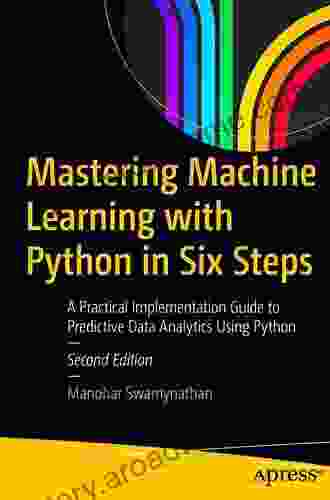Master Predictive Data Analytics with Python: The Ultimate Guide

In today's data-driven world, businesses and organizations are increasingly relying on predictive data analytics to gain insights into their data and make informed decisions. Predictive data analytics involves using statistical techniques and machine learning algorithms to forecast future outcomes based on historical data. By leveraging predictive analytics, businesses can:
4.3 out of 5
| Language | : | English |
| File size | : | 18190 KB |
| Text-to-Speech | : | Enabled |
| Screen Reader | : | Supported |
| Enhanced typesetting | : | Enabled |
| Print length | : | 478 pages |
- Identify trends and patterns in their data
- Predict future events and outcomes
- Make better decisions
- Gain a competitive advantage
If you're a data analyst, data scientist, or business professional who wants to learn how to use predictive data analytics, then this guide is for you. In this guide, we will cover:
- The basics of predictive data analytics
- The different types of predictive analytics techniques
- How to apply predictive analytics to your own data
- The benefits of using predictive data analytics
The Basics of Predictive Data Analytics
Predictive data analytics is a branch of data analysis that uses statistical techniques and machine learning algorithms to forecast future outcomes based on historical data. Predictive analytics can be used to predict a wide variety of outcomes, such as:
- Customer churn
- Sales trends
- Equipment failures
- Financial performance
- Risk
Predictive analytics is based on the assumption that past data can be used to predict future events. This assumption is not always true, but it is often a good starting point for developing predictive models.
The Different Types of Predictive Analytics Techniques
There are many different types of predictive analytics techniques, each with its own strengths and weaknesses. Some of the most common predictive analytics techniques include:
- Regression analysis
- Decision trees
- Random forests
- Neural networks
- Time series analysis
The best predictive analytics technique for a particular problem will depend on the nature of the data and the desired outcome.
How to Apply Predictive Analytics to Your Own Data
If you want to apply predictive analytics to your own data, there are a few steps you need to follow:
- Gather your data. The first step is to gather the data that you want to use for predictive analytics. This data can come from a variety of sources, such as customer databases, sales records, or financial statements.
- Clean and prepare your data. Once you have gathered your data, you need to clean and prepare it for analysis. This involves removing any duplicate or missing data, and converting the data into a format that can be used by your chosen predictive analytics software.
- Choose a predictive analytics technique. The next step is to choose a predictive analytics technique that is appropriate for your data and the desired outcome. There are many different predictive analytics techniques available, so it is important to choose one that is well-suited to your needs.
- Develop a predictive model. Once you have chosen a predictive analytics technique, you need to develop a predictive model. This involves training the model on your data and evaluating its performance.
- Deploy your predictive model. Once you have developed a predictive model, you need to deploy it into production. This involves making the model available to users so that they can use it to make predictions.
The Benefits of Using Predictive Data Analytics
Predictive data analytics can provide a number of benefits to businesses and organizations, including:
- Improved decision-making. Predictive analytics can help businesses make better decisions by providing insights into the future. By forecasting future outcomes, businesses can make more informed decisions about product development, marketing, and operations.
- Increased sales. Predictive analytics can help businesses increase sales by identifying opportunities to create personalized marketing campaigns and target customers who are likely to buy. Predictive analytics can also be used to forecast demand for products and services, which can help businesses avoid overstocking or understocking.
- Reduced risk. Predictive analytics can help businesses reduce risk by identifying potential problems and risks. By forecasting future outcomes, businesses can take steps to mitigate risks and protect themselves from financial losses.
- Improved customer service. Predictive analytics can help businesses improve customer service by identifying customers who are at risk of churning and providing them with personalized support. Predictive analytics can also be used to forecast demand for customer service, which can help businesses staff their customer service departments accordingly.
Predictive data analytics is a powerful tool that can help businesses and organizations gain insights into their data and make better decisions. By leveraging predictive analytics, businesses can improve their sales, reduce their risk, and improve their customer service. If you're a data analyst, data scientist, or business professional who wants to learn how to use predictive data analytics, then this guide is for you. In this guide, we have covered the basics of predictive data analytics, the different types of predictive analytics techniques, how to apply predictive analytics to your own data, and the benefits of using predictive data analytics.
4.3 out of 5
| Language | : | English |
| File size | : | 18190 KB |
| Text-to-Speech | : | Enabled |
| Screen Reader | : | Supported |
| Enhanced typesetting | : | Enabled |
| Print length | : | 478 pages |
Do you want to contribute by writing guest posts on this blog?
Please contact us and send us a resume of previous articles that you have written.
 Book
Book Novel
Novel Page
Page Chapter
Chapter Text
Text Story
Story Genre
Genre Reader
Reader Library
Library Paperback
Paperback E-book
E-book Magazine
Magazine Newspaper
Newspaper Paragraph
Paragraph Sentence
Sentence Bookmark
Bookmark Shelf
Shelf Glossary
Glossary Bibliography
Bibliography Foreword
Foreword Preface
Preface Synopsis
Synopsis Annotation
Annotation Footnote
Footnote Manuscript
Manuscript Scroll
Scroll Codex
Codex Tome
Tome Bestseller
Bestseller Classics
Classics Library card
Library card Narrative
Narrative Biography
Biography Autobiography
Autobiography Memoir
Memoir Reference
Reference Encyclopedia
Encyclopedia Mary Katherine Backstrom
Mary Katherine Backstrom Ron Brown
Ron Brown Laura Coia
Laura Coia Marius P Castillo
Marius P Castillo Luxing Li
Luxing Li Polinpapilinho F Katina
Polinpapilinho F Katina Lia Luzzatto
Lia Luzzatto Tim Flannery
Tim Flannery Liz Fichera
Liz Fichera Christopher Pierznik
Christopher Pierznik Marion Roach Smith
Marion Roach Smith Maharishi Mahesh Yogi
Maharishi Mahesh Yogi Mark Victor Hansen
Mark Victor Hansen Linda Johansen
Linda Johansen Valentino Pennella
Valentino Pennella Lynn Casteel Harper
Lynn Casteel Harper Sally Warner
Sally Warner Mahvash Khajavi Harvey
Mahvash Khajavi Harvey Pamela J Baker
Pamela J Baker Walter A Elwell
Walter A Elwell
Light bulbAdvertise smarter! Our strategic ad space ensures maximum exposure. Reserve your spot today!

 Richard AdamsUnlock the Profound Power of Daily Prayer: Discover the "Treasury Of Daily...
Richard AdamsUnlock the Profound Power of Daily Prayer: Discover the "Treasury Of Daily...
 Richard SimmonsPrepare for Your Mind to Be Blown: Unveiling the Unforgettable 'The In Your...
Richard SimmonsPrepare for Your Mind to Be Blown: Unveiling the Unforgettable 'The In Your... Jett PowellFollow ·6.4k
Jett PowellFollow ·6.4k Ron BlairFollow ·4.4k
Ron BlairFollow ·4.4k Bo CoxFollow ·5.6k
Bo CoxFollow ·5.6k Jorge AmadoFollow ·7.9k
Jorge AmadoFollow ·7.9k Giovanni MitchellFollow ·6.3k
Giovanni MitchellFollow ·6.3k Robert ReedFollow ·18.3k
Robert ReedFollow ·18.3k Richard WrightFollow ·12.8k
Richard WrightFollow ·12.8k Everett BellFollow ·14.9k
Everett BellFollow ·14.9k

 E.M. Forster
E.M. ForsterThe Real Blueprint to Short-Term Rental Success
Are you ready to create a...

 Mark Mitchell
Mark MitchellMidas Touch: The Astrology Of Wealth
Are you ready to tap into the cosmic forces...

 Grant Hayes
Grant HayesPrecarious Creativity: Unpacking the Global Media and...
In the ever-evolving landscape of the...

 Cameron Reed
Cameron ReedGuru Govind Singh: A Life of Courage and Inspiration for...
Guru Govind Singh, the tenth Sikh guru,...

 Yukio Mishima
Yukio MishimaCastles & Shapes: The Enchanting World of Ris...
In the realm of...

 Jerome Blair
Jerome BlairGolden Keys To Jyotisha Volume Ten: The Ultimate Guide to...
Embark on an...
4.3 out of 5
| Language | : | English |
| File size | : | 18190 KB |
| Text-to-Speech | : | Enabled |
| Screen Reader | : | Supported |
| Enhanced typesetting | : | Enabled |
| Print length | : | 478 pages |








